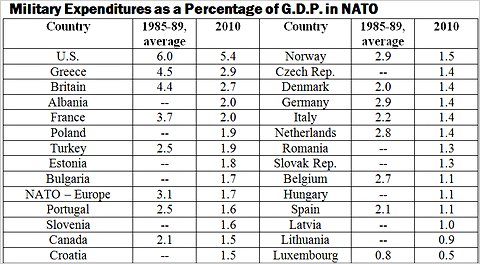
From Tomas Valasek, the Center for European Reform: Even before the latest cuts, in April 2011, the Obama administration ordered the withdrawal of one of the four remaining US brigade combat teams (BCTs) from Europe. This was a less dramatic reduction than the one that George Bush’s government initially ordered in 2004 – then, the Pentagon decided to cut half the BCTs but subsequently put the decision on hold because they were needed in Afghanistan. In reducing the cut to just on BCT in 2011, the Pentagon cited the need to assure allies (mainly in Central Europe) that Washington remains committed to their defence. But it now seems very probable that the Defense Department, under pressure to save money, will withdraw the second BCT after all.
Many US military facilities in Western Europe are in danger. Their number has gradually dwindled as the US reduced forces from the Cold War average of 311,000 to fewer than 80,000 today. Many more will now be closed. The US military sees the smaller bases in particular as a source of relatively easy savings. While installations such as the large US military hospital in Landshut, Germany are likely to fare well, the 700-strong US Air Force base in Lajes, Portugal, will probably go. Non-essential facilities such as the George C Marshall Center in Germany (a school for military officers, mainly from Eastern Europe and Asia) are also vulnerable.
These departures are certain to be unpopular with local governments around Europe, some of which will suffer a double or triple setback. In addition to expected US base closures, NATO and national governments have also been cutting budgets and forces. Portugal, which will probably lose Lajes, had recently seen NATO decide to close its ‘Joint Force Command’ near Lisbon. Germany plans to close many of its own bases to save money; it now stands to lose some of the US ones as well. The closures will cause tensions among local and national governments but the impact on transatlantic relations will be limited – because virtually all allied capitals are reducing forces, none will be in a position to complain. But the US and European militaries will lose some of the existing opportunities to train together. And the loss of schools such as the George C Marshall Center would deprive the allies of the ability to win the hearts and minds of young officers in dangerous parts of the world such as South Caucasus and Central Asia.
With cuts to US defence budget looming, the US will also forgo its ability to pressurise the Europeans against reductions in their own spending. Apparently at the first meeting between Leon Panetta, the new Pentagon chief, and Liam Fox, the UK defence secretary, the two swapped lessons on how to cut budgets with least political pain. A year ago the US defence secretary would have sought to restrain the UK from cutting in the first place.
There is a real danger that cuts on one end of the Atlantic will encourage more cuts on the other end, thus degrading NATO’s credibility. While some of the bases that the United States is thinking of closing may well be redundant, NATO defence guarantees will lose their meaning unless the allies maintain a certain minimum number of forces and military installations. In theory, the Europeans should be responding to US force cuts by studying whether NATO is close to reaching this threshold, and whether they need to augment their forces to replace the departing US ones. But the opposite is likely to happen: without US pressure, many European governments will feel freer than ever to reduce military spending and forces. This may yet turn out to be the most significant and corrosive legacy of current US budgets cuts for allied security.
Tomas Valasek is director of foreign policy and defence at the Center for European Reform. (graphic: NATO/New York Times)
Image: nato%207%2015%2011%20defense%20budgets%20GDP_0.jpg
